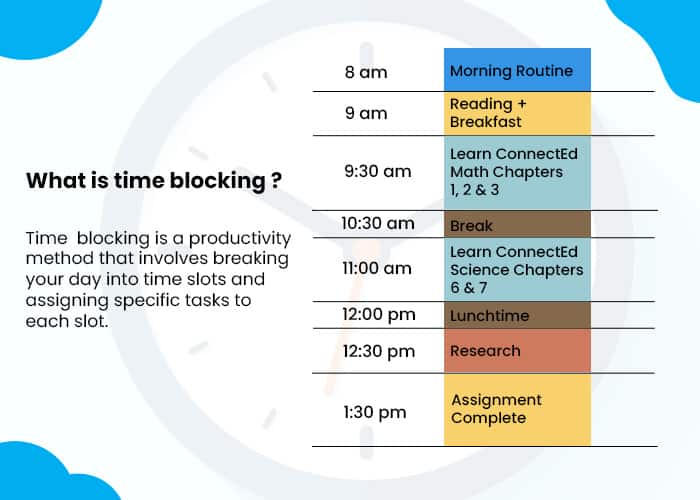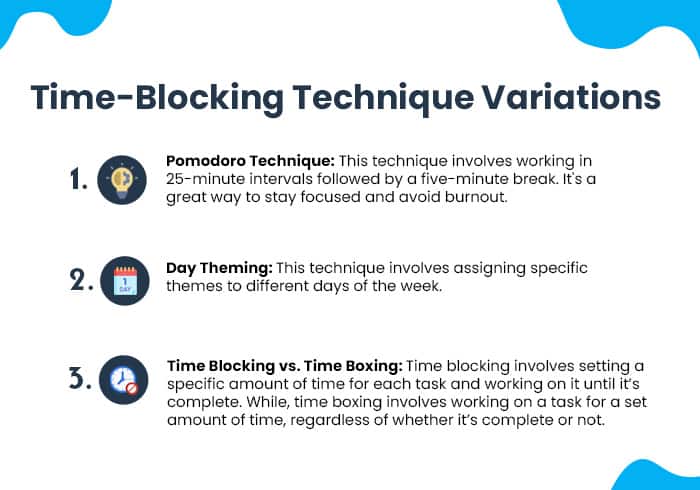Time is a finite resource that we all have, and how we manage it determines our success or failure in achieving our goals. The traditional to-do list is a great tool, but it doesn’t provide a clear path to success. This is where time blocking comes in – it’s a method of scheduling tasks and activities in dedicated time slots throughout the day. In this blog, we’ll explore what time blocking is, how to use it, and its variations to help you get more productive and achieve your goals.
What exactly is the Time Blocking Method?
Time blocking is a productivity method that involves breaking your day into time slots and assigning specific tasks to each slot. This method allows you to plan your day in advance, prioritize your tasks, and create a structured schedule to follow. You can use a time-blocking calendar to visually plan and allocate time for each task. With time blocking, you’re not just writing a list of tasks that you want to accomplish for the day. Instead, you’re planning your day around your tasks. This way, you’re not only deciding what you’ll do for the day but also determining when you’ll do them. The idea behind time blocking is that it helps you manage your time more efficiently. It prevents you from jumping from task to task, losing focus and productivity in the process. Instead, it allows you to stay focused and work on one task at a time.

How to Use Time Blocking Method?
The first step in using time blocking is to create a list of all the tasks you need to complete. Then, assign a specific amount of time for each task based on its importance and urgency. For example, if you have a report to write that will take four hours, you might block off four hours on your calendar to work on it. It’s essential to prioritize your tasks and block off time for the most important ones first. This ensures that you’re using your time effectively and accomplishing the most critical tasks before moving on to less important ones. Additionally, you should leave some buffer time between tasks to avoid feeling overwhelmed or burnt out.
Once you’ve created your time-blocking schedule, it’s important to stick to it as much as possible. Avoid distractions and interruptions during your blocked-off time. Turn off your phone, log out of social media, and avoid any non-work-related activities. This will help you stay focused and get more done in less time.
What are the different Time-Blocking Variations?
There are different variations of time-blocking that you can use to match your preferences and work style. Here are some of the most common ones:
- Pomodoro Technique: This technique involves working in 25-minute intervals followed by a five-minute break. It’s a great way to stay focused and avoid burnout. The Pomodoro technique is an excellent way to work on tasks that require a lot of focus. It involves breaking down your work into intervals, usually 25 minutes long. After each interval, you take a five-minute break to help you rest and recharge. This technique allows you to work for short periods of time and stay focused throughout the day.
- Day Theming: This technique involves assigning specific themes to different days of the week. For example, you could have a marketing day, a sales day, and a networking day. Day theming is an excellent way to help you focus on specific tasks or projects. Assigning themes to different days of the week ensures that you’re working on the same type of task on the same day each week. This method helps you get into the right mindset for each task and allows you to work more efficiently.

- Time Blocking vs. Time Boxing: Time blocking and time boxing are often used interchangeably, but they’re not the same. Time blocking involves setting a specific amount of time for each task and working on it until it’s complete. On the other hand, time boxing involves working on a task for a set amount of time, regardless of whether it’s complete or not. Both methods can be effective, but they work best in different situations.
How to get more productive with the Time Blocking Method.
Time blocking is an excellent tool for increasing productivity and achieving your goals. Here are some tips to help you get the most out of this productivity method:
- Prioritize your tasks – Make a list of all the tasks you need to complete and prioritise them based on their importance and urgency. This ensures that you’re focusing on the most important tasks first.
- Use a time-blocking calendar – A time-blocking calendar is a great tool to help you visually plan and allocate time for each task. You can use a paper calendar or an app, whichever works best for you.
- Leave some buffer time – Avoid scheduling tasks back to back. Leave some buffer time between tasks to avoid feeling overwhelmed or burnt out.
- Avoid distractions – Turn off your phone, log out of social media, and avoid any non-work-related activities during your blocked-off time. This will help you stay focused and get more done in less time.
Conclusion
In conclusion, time blocking is a powerful tool for increasing productivity and achieving your goals. By breaking your day into time slots and assigning specific tasks to each slot, you can plan your day in advance, prioritize your tasks, and create a structured schedule to follow. With time blocking, you can stay focused, avoid distractions, and get more done in less time. Use these tips to get the most out of this productivity method and start achieving your goals today.



